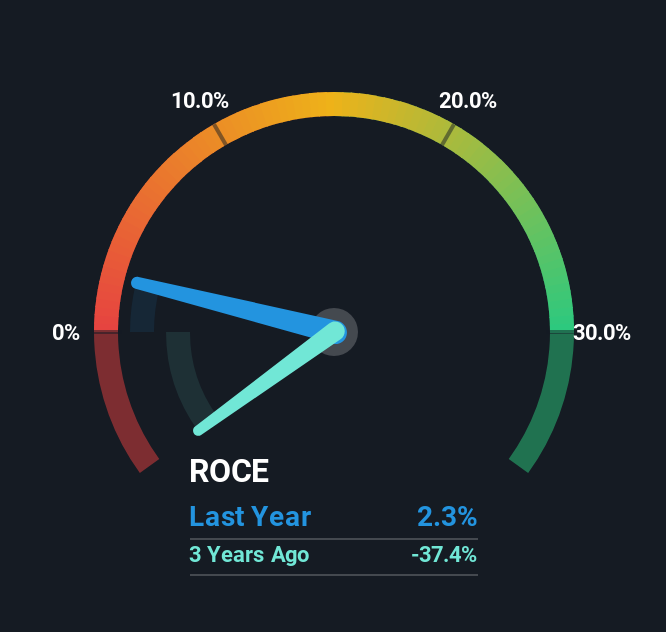Sarawak Consolidated Industries Berhad (KLSE:SCIB) Might Be Having Difficulty Using Its Capital Effectively
Finding a business that has the potential to grow substantially is not easy, but it is possible if we look at a few key financial metrics. Typically, we'll want to notice a trend of growing return on capital employed (ROCE) and alongside that, an expanding base of capital employed. Ultimately, this demonstrates that it's a business that is reinvesting profits at increasing rates of return. However, after investigating Sarawak Consolidated Industries Berhad (KLSE:SCIB), we don't think it's current trends fit the mold of a multi-bagger.
Return On Capital Employed (ROCE): What Is It?
If you haven't worked with ROCE before, it measures the 'return' (pre-tax profit) a company generates from capital employed in its business. The formula for this calculation on Sarawak Consolidated Industries Berhad is:
Return on Capital Employed = Earnings Before Interest and Tax (EBIT) ÷ (Total Assets - Current Liabilities)
0.023 = RM5.7m ÷ (RM344m - RM99m) (Based on the trailing twelve months to June 2025).
Thus, Sarawak Consolidated Industries Berhad has an ROCE of 2.3%. Ultimately, that's a low return and it under-performs the Building industry average of 8.9%.
See our latest analysis for Sarawak Consolidated Industries Berhad

While the past is not representative of the future, it can be helpful to know how a company has performed historically, which is why we have this chart above. If you're interested in investigating Sarawak Consolidated Industries Berhad's past further, check out this free graph covering Sarawak Consolidated Industries Berhad's past earnings, revenue and cash flow.
What The Trend Of ROCE Can Tell Us
Unfortunately, the trend isn't great with ROCE falling from 8.0% five years ago, while capital employed has grown 66%. Usually this isn't ideal, but given Sarawak Consolidated Industries Berhad conducted a capital raising before their most recent earnings announcement, that would've likely contributed, at least partially, to the increased capital employed figure. Sarawak Consolidated Industries Berhad probably hasn't received a full year of earnings yet from the new funds it raised, so these figures should be taken with a grain of salt.
On a related note, Sarawak Consolidated Industries Berhad has decreased its current liabilities to 29% of total assets. So we could link some of this to the decrease in ROCE. Effectively this means their suppliers or short-term creditors are funding less of the business, which reduces some elements of risk. Some would claim this reduces the business' efficiency at generating ROCE since it is now funding more of the operations with its own money.
The Bottom Line
In summary, Sarawak Consolidated Industries Berhad is reinvesting funds back into the business for growth but unfortunately it looks like sales haven't increased much just yet. And investors may be expecting the fundamentals to get a lot worse because the stock has crashed 77% over the last five years. On the whole, we aren't too inspired by the underlying trends and we think there may be better chances of finding a multi-bagger elsewhere.
On a final note, we found 4 warning signs for Sarawak Consolidated Industries Berhad (3 are potentially serious) you should be aware of.
While Sarawak Consolidated Industries Berhad may not currently earn the highest returns, we've compiled a list of companies that currently earn more than 25% return on equity. Check out this free list here.
New: Manage All Your Stock Portfolios in One Place
We've created the ultimate portfolio companion for stock investors, and it's free.
• Connect an unlimited number of Portfolios and see your total in one currency
• Be alerted to new Warning Signs or Risks via email or mobile
• Track the Fair Value of your stocks
Have feedback on this article? Concerned about the content? Get in touch with us directly. Alternatively, email editorial-team (at) simplywallst.com.
This article by Simply Wall St is general in nature. We provide commentary based on historical data and analyst forecasts only using an unbiased methodology and our articles are not intended to be financial advice. It does not constitute a recommendation to buy or sell any stock, and does not take account of your objectives, or your financial situation. We aim to bring you long-term focused analysis driven by fundamental data. Note that our analysis may not factor in the latest price-sensitive company announcements or qualitative material. Simply Wall St has no position in any stocks mentioned.
About KLSE:SCIB
Sarawak Consolidated Industries Berhad
An investment holding company, manufactures and sells precast concrete products and industrialized building systems for use in the infrastructure and construction industries primarily in Malaysia.
Slight risk and slightly overvalued.
Market Insights
Community Narratives


Recently Updated Narratives

TAV Havalimanlari Holding will fly high with 25.68% revenue growth


Fiducian: Compliance Clouds or Value Opportunity?


Q3 Outlook modestly optimistic
Popular Narratives


MicroVision will explode future revenue by 380.37% with a vision towards success


The company that turned a verb into a global necessity and basically runs the modern internet, digital ads, smartphones, maps, and AI.



